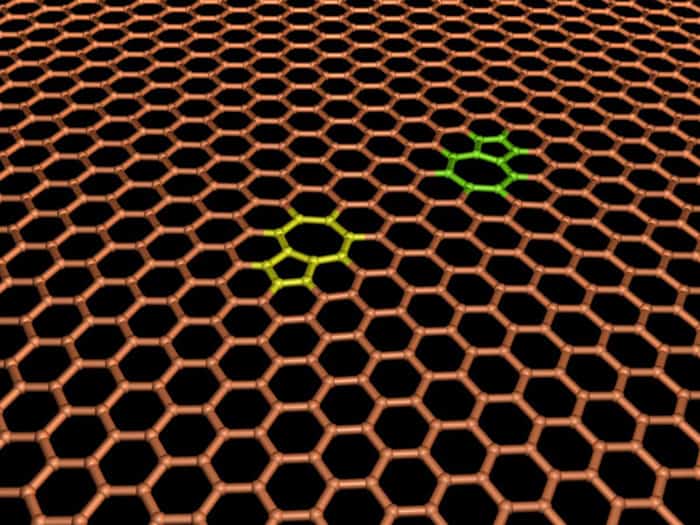
Molecular graphenoids make coherent spin centres
by Belle DuméQuantum dots made of molecular graphene containing pentagon-shaped defects could form the basis of a new generation of quantum sensors. This is the finding of researchers in the UK and Germany who made the dots, or “graphenoids”, using a bottom-up chemical process rather than the top-down methods usually employed to create such nanostructures. The researchers say that such graphenoids could be employed in carbon-based devices that exploit quantum-mechanical effects to sense their environment.
Quantum technologies rely on manipulating the quantum properties of charges, spins or photons. Quantum spins in material defects such as nitrogen-vacancy (NV) centres in diamond are a popular platform for this work, but defects in other carbon materials – including graphene, a one-dimensional sheet of carbon atoms arranged in a hexagonal honeycomb lattice – also show promise.
Researchers have explored various ways of introducing spin defects into carbon nanomaterials, including encasing heteroatoms inside fullerenes, confining electrons in carbon nanotubes and functionalizing carbon nanoribbons. However, whereas the position of NV centres can be controlled with atomic precision, it has proved more difficult to control the locations of other carbon-based point defects. Indeed, researchers only managed to do so quite recently by introducing organic molecules with heptagonal ring structures at specific positions into graphene.
Bottom-up approach
A team of researchers led by Lapo Bogani at Oxford University in the UK have built on this work by introducing a saddle-shaped organic molecule into the hexagonal lattice of graphene. They chose this molecule – a “radicaloid” known as diindeno-fused bischrysen – because it incompletely hydrogenates in the final processing step, producing open-pentagonal-shell monoradical species that can act as defects.
In the past, graphene nanoribbons and other defect-bearing structures could only be obtained by starting with an advanced structure and modifying it, for example by making carbon nanotubes and then unzipping them. These top-down techniques invariably produced structures with undefined edges and uncontrollable defects, Bogani explains. In contrast, he and his team synthesized their diindeno-fused bischrysen from 11,11′- dibromo-5,5′-bichrysene in a five-step bottom-up chemical process that starts with small molecular precursors and builds up the final molecule.
The researchers checked every stage of this process with high-precision chemical characterization techniques, including mass spectroscopy and nuclear magnetic resonance (NMR). This enabled them to accurately determine the position of the pentagonal defects in the honeycomb lattice of graphene.
Long coherence time
The researchers report that when they put the spins of the resulting defects into a quantum superposition, the superposition remained coherent for up to 100 µs. Long coherence times are of paramount importance for quantum operations, and Bogani says that the robustness of the superposition in their system is due to low quantum noise from the nuclear spins in the molecule, as well as a low intrinsic spin-orbit coupling since the only elements in the structure are carbon and hydrogen.
The team, which includes researchers from Technische Universität Dresden and the Max Planck Institut für Polymerforschung, say that they will now be probing the quantum properties of their defects at room temperature by introducing the organic molecule they synthesized into matrices of solid systems such as liquid crystals or porous metal-organic frameworks. According to Bogani, possible applications include spintronics and optoelectronics devices as well as biological sensors.
“Our work straddles both quantum physics and synthetic chemistry and it paves the way to quantum manipulation of magnetic graphene-based structures in the future,” he tells Physics World.
Full details of the research are reported in Science Advances.